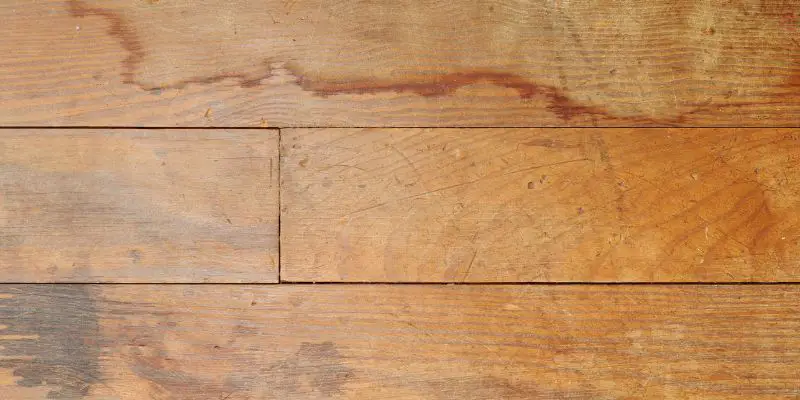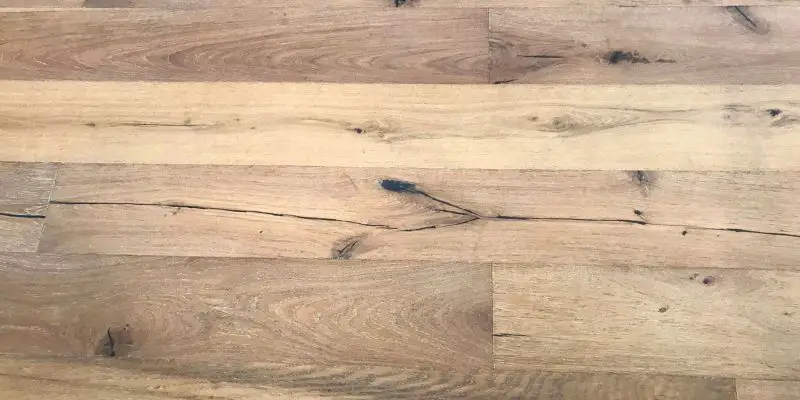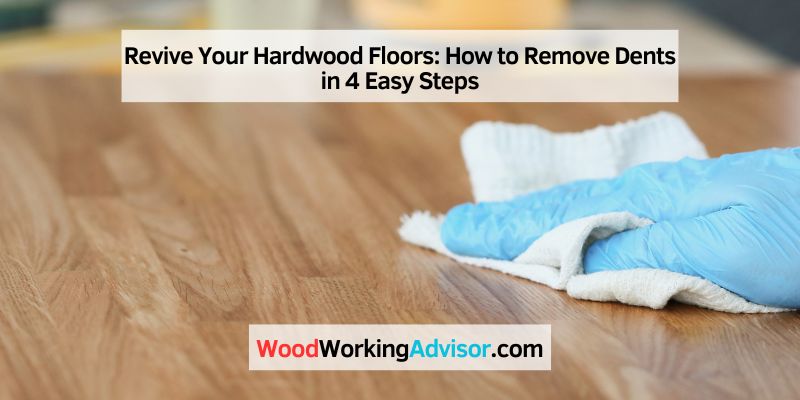To remove dents from finished hardwood floors, use a hot iron and a damp cloth. An effective method to eliminate dents from finished hardwood floors involves using a hot iron and a damp cloth.
Place the damp cloth over the dent, then apply the hot iron to the cloth, moving it in a circular motion for about 30 seconds. This heat and moisture combination will cause the wood to expand, effectively reducing the appearance of the dent.
Once the dent is gone, allow the area to cool and dry before polishing or refinishing the floor if necessary. Remember to always test this method in an inconspicuous area first to ensure it does not cause any damage.
Understanding Hardwood Floor Dents
Hardwood floors are a beautiful addition to any home, adding a touch of elegance and warmth to the space. However, over time, these floors can develop unsightly dents that can detract from their overall appearance. Understanding what causes these dents and the different types that can occur is key to successfully removing them and restoring your floors to their former glory.
Causes Of Dents
Dents in hardwood floors can be caused by a variety of factors, ranging from heavy furniture to dropped objects. By being aware of these common causes, you can take preventative measures to minimize the risk of dents in the first place.
- Prolonged pressure: Heavy furniture or appliances that sit in one spot for an extended period of time can create indentations in the hardwood. This is why it’s important to use furniture pads or rearrange your furniture periodically.
- Sharp objects: Accidentally dropping sharp objects like knives or tools on the floor can leave noticeable dents. Handling such items with care and not allowing them to come into contact with the floor is crucial.
- Pets: Our furry friends can also contribute to dents in hardwood floors. Running and playing with sharp claws can easily leave marks. Regularly trimming your pet’s nails and providing them with appropriate toys and scratching posts can help prevent these issues.
Types Of Dents
Dents in hardwood floors come in different shapes and sizes, each requiring a specific approach for their removal. Understanding the type of dent you’re dealing with is essential to effectively restore your floors.
- Shallow dents: These are small, surface-level dents that can be easily fixed by using the steam method or with a damp cloth and a hot iron. The heat helps to expand the wood fibers, allowing them to regain their original shape.
- Deep dents: As the name suggests, these dents are more significant and may require a more involved treatment. Options for addressing deep dents include using a steam iron, applying heat with a hairdryer, or using wood putty to fill the dent and then refinishing the area.
- Cracks or split wood: In more severe cases, hardwood floors can develop cracks or split wood. These issues require professional assistance, as they may involve more complex repairs, such as partial or full floor replacement.

Assessing The Damage
If you have dents on your finished hardwood floors, assessing the damage can be the first step toward removing them. One way to remove dents involves using a damp cloth and an iron to steam out the dented area. Another method is to use a hardwood floor repair kit to fill and smooth the dented spot.
Inspecting The Dents
When it comes to removing dents from your finished hardwood floors, the first step is to assess the damage and determine the best course of action. Inspecting the dents up close is essential in understanding the severity and depth of the damage.
Start by examining the affected area carefully. Look for any visible signs such as cracks, splits, or splinters. It’s important to differentiate between shallow surface dents and deeper ones that may have penetrated the finish and reached the wood underneath.
Use your fingertips to gently feel the dented area, ensuring that you apply light pressure. This will help you determine the extent and depth of the dent. You may even notice if the dent is still flexible or if it has hardened over time. Take note of the dimensions and shape of each dent, as this information will be useful in determining the appropriate repair technique.
Determining Repair Options
Once you’ve inspected the dents and have a better understanding of the damage, it’s time to consider your repair options. Depending on the severity and type of dents, different methods may be more suitable for your specific situation.
If you’re dealing with minor surface dents, a simple remedy may be all that’s needed. This could involve using hot water, a steam iron, or even a hairdryer to apply heat and moisture to the area. The goal here is to make the wood more pliable, allowing the dent to gradually rise back to its original position.
In cases where the dents are deeper and have penetrated the finish, more extensive repairs may be required. This could involve sanding down the affected area to remove any damaged finish and wood. Once the surface is smooth and even, you can proceed with refinishing or staining to restore the floor’s appearance.
Remember, each repair option has its advantages and limitations. Factors such as the size and number of dents, your comfort level with DIY methods, and the availability of materials and equipment should all be considered when determining the best course of action.
Diy Methods For Removing Dents
When it comes to maintaining the pristine appearance of your hardwood floors, dents can be a major eyesore. However, with the right DIY methods, you can effectively remove dents from your finished hardwood floors, restoring them to their original glory without the need for expensive professional assistance. In this section, we’ll explore some practical DIY methods for removing dents from your hardwood floors, allowing you to tackle this issue with confidence and ease.
Applying Moisture And Heat
To remove dents from finished hardwood floors, a commonly used DIY method involves applying moisture and heat to the affected area. By using this technique, you can often coax the wood fibers back into place, effectively minimizing the dent and restoring the floor to its original smoothness.
Using A Wet Cloth And Iron
One effective way to apply moisture and heat to the dented area is by using a wet cloth and an iron. Simply dampen a cloth and place it over the dent, then carefully run a warm iron over the cloth. The combination of moisture and heat will help to expand the wood fibers, allowing the dent to gradually diminish.
Professional Solutions For Deep Dents
Remove deep dents from your finished hardwood floors with our professional solutions. Effortlessly restore the beauty of your floors with our expert techniques and leave them looking flawless.
When it comes to deep dents in your finished hardwood floors, sometimes it’s best to call in the experts. Attempting to fix these types of dents yourself may result in further damage or an unsatisfactory outcome. Professional floor repair experts have the knowledge, experience, and specialized tools to effectively remove deep dents and restore the beauty of your hardwood floors.
Calling In A Floor Repair Expert
If you are dealing with deep dents in your hardwood floors and want to ensure the best possible repair, it is wise to consider hiring a floor repair expert. These professionals have extensive experience in handling various types of floor damage and possess the necessary expertise to restore your floors to their former glory.
There are several reasons why contacting a floor repair expert is the right choice for deep dents. Firstly, these experts have access to specialized equipment and tools designed specifically for repairing hardwood floors. They know which techniques and products to use to ensure a seamless repair. Additionally, their knowledge of different hardwood floor finishes allows them to select the most appropriate methods for removing dents without causing further damage.
Moreover, floor repair experts are well-versed in the art of blending and matching finishes. This means that once the dent is removed, it can seamlessly restore the finish of the affected area, making it virtually indistinguishable from the rest of the floor. Their attention to detail ensures a professional-looking result that you can be proud of.
Considerations For Severe Damage
In cases of severe damage, such as deep dents that are accompanied by cracks, it becomes even more crucial to consult a professional. Attempting to repair severe damage on your own may worsen the situation and lead to more costly repairs in the long run.
A floor repair expert can assess the severity of the damage and determine the best course of action. They may recommend additional steps such as filling the cracks, replacing damaged boards, or refinishing the entire floor if necessary. By entrusting the repair process to an expert, you can have peace of mind knowing that the damage will be addressed comprehensively.
Before hiring a floor repair expert, it is important to do some research and find a reputable professional in your area. Look for someone with positive reviews, relevant experience, and proper certifications. Also, don’t hesitate to ask for a cost estimate and timeline for the repair process.
By opting for professional solutions for removing deep dents in your finished hardwood floors, you are investing in the long-term durability and beauty of your home. The expertise and specialized tools that floor repair experts bring to the table ensure a smooth and seamless repair, leaving your floors looking flawless once again.
Preventive Measures For Future Dents
Taking preventive measures is key to ensuring the longevity of your hardwood floors and preventing future dents. By following these simple tips, you can protect your floors from unnecessary damage and maintain their pristine condition for years to come.
Rug Placement And Furniture Pads
Placing rugs strategically in high-traffic areas and under heavy furniture can help distribute weight and reduce the chances of dents. Here are some guidelines to follow when it comes to rug placement:
- Place a rug at entrances and hallways to prevent dirt and debris from being tracked onto the floor.
- Use non-slip rug pads underneath the rugs to prevent them from sliding and causing accidental damage.
- Consider using area rugs in living rooms and dining areas to protect the wood from scratches and furniture legs.
Furthermore, using furniture pads is essential to prevent dents and scratches caused by furniture. Here’s why you should consider using furniture pads:
- Attach felt pads or rubber bumpers to the bottom of the chair and table legs to create a cushioning effect and protect your floors.
- Regularly check and replace worn-out or damaged pads to ensure continuous protection.
- Pay special attention to heavy furniture, such as sofas, beds, and cabinets, as they can cause more significant damage if not properly cushioned.
Regular Maintenance Tips
Regular maintenance plays an integral role in keeping your hardwood floors dent-free. Here are some useful tips for ongoing care:
- Keep the floors clean by regularly sweeping or vacuuming to remove dirt and small particles that can cause scratches or dents.
- Use a damp mop with a pH-neutral cleaner specifically designed for hardwood floors to keep them looking their best.
- Avoid using excessive water or harsh chemicals, as they can damage the finish and lead to dents.
- Wipe up spills immediately to prevent moisture from seeping into the wood and causing warping or denting.
- Avoid wearing high heels or shoes with sharp heels on hardwood floors, as they can easily dent the surface.
To summarize, taking preventive measures such as strategic rug placement and using furniture pads, along with regular maintenance, can help protect your hardwood floors from dents and keep them looking beautiful for years to come. By implementing these tips, you can enjoy your hardwood floors worry-free, knowing that you’re doing everything possible to maintain their pristine condition.

Frequently Asked Questions Of How To Remove Dents From Finished Hardwood Floors
How Do You Get Dents Out Of Finished Wood?
To remove dents from finished wood, you can use the steam method. Wet a cloth, place it over the dent, and iron over it. The steam will swell the wood fibers, and the dent should pop back up. Be careful not to leave the iron on for too long to avoid damaging the finish.
How Do You Get Dents Out Of Prefinished Hardwood Floors?
To remove dents from prefinished hardwood floors, use a steam iron and a damp cloth. Place the cloth over the dent, apply the iron for 30 seconds, and repeat until the dent lifts. If the dent persists, lightly sand and refinish the area for a seamless look.
Can You Get Dents Out Of Engineered Hardwood Floors?
Yes, dents can be removed from engineered hardwood floors.
How Do You Remove Gouges From Hardwood Floors?
To remove gouges from hardwood floors, first, clean the affected area. Then, use wood filler to fill the gouges, ensuring they match the floor color. Sand the filled spots gently until smooth, and finish by applying a coat of polyurethane or wax to blend with the rest of the floor.
Conclusion
Knowing how to remove dents from finished hardwood floors is essential for maintaining the beauty of your home. By using simple techniques such as steam treatment and wood filler, you can restore your floors to their original glory. With proper care and attention, your hardwood floors will continue to enhance the aesthetic appeal of your space for years to come.


